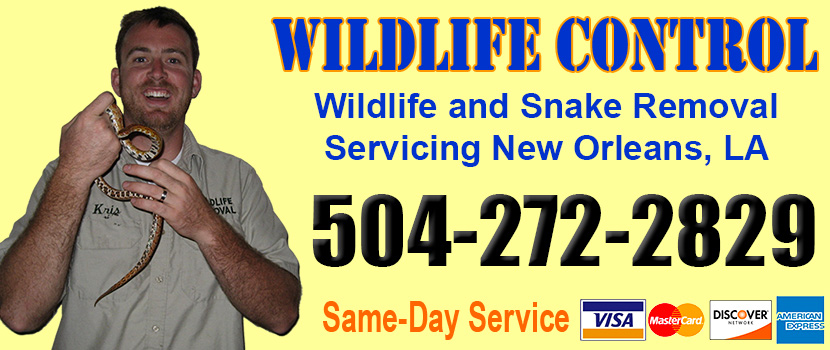
Welcome to neworleanssnakes.com! I am David, a snake enthusiast living in New Orleans, LA. Many people don't know that New Orleans is in fact full of snakes! You just need to know where to find them - they can often be shy and elusive. Some Louisiana snake species are more common outside of the city limits, in different parts of Orleans County LA, but many types of snakes are indeed common in the more urban parts of New Orleans. This guide is meant to help educate you about the beautiful snakes of New Orleans, and to help you identify the most common snakes of New Orleans, as well as the venomous snakes of New Orleans that you should learn to recognize and avoid. If you want more detail, click here for my complete list of ALL snake species in New Orleans. Remember the following:
- Most snakes of New Orleans are harmless and don't want to encounter you
- Venomous snakes exist but are uncommon in New Orleans, Louisiana
- Snakes eat rats and mice and are a valuable part of the Louisiana ecosystem
- Never kill a snake - if you leave a snake alone, it will leave you alone.
Common Snake Species in New Orleans
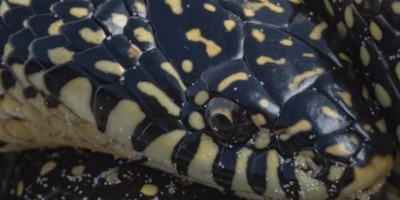 Speckled kingsnake:
The speckled kingsnake is a large constrictor. It is also known as the salt and pepper snake. The snakes have a small head, which is almost the same size as their neck. They have black or red eyes and a slim, smooth body. Although there are many variations in colors, kingsnakes generally have a black or dark body, with light yellow or tiny white spots down their backs. The underside of the snake is pale cream or a pale shade of yellow. They can grow up to a length of 48 inches. They have a preference for damp places like swamps, marshes, open fields, pastures, near water bodies, and woodlands. They feed on different prey, including small mammals, frogs, birds, and other snake species.
Speckled kingsnake:
The speckled kingsnake is a large constrictor. It is also known as the salt and pepper snake. The snakes have a small head, which is almost the same size as their neck. They have black or red eyes and a slim, smooth body. Although there are many variations in colors, kingsnakes generally have a black or dark body, with light yellow or tiny white spots down their backs. The underside of the snake is pale cream or a pale shade of yellow. They can grow up to a length of 48 inches. They have a preference for damp places like swamps, marshes, open fields, pastures, near water bodies, and woodlands. They feed on different prey, including small mammals, frogs, birds, and other snake species.
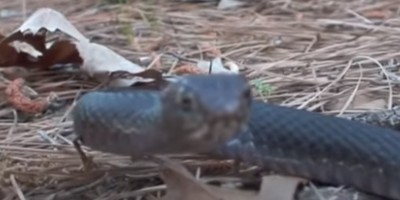 Coachwhip snake:
The snake has a dark brown or black head that progressively becomes pale in color towards the tail. The belly of the snake is pale white or pink. Young snakes have irregularly arranged black crossbars on their back, over a tan background color. The coachwhip snake has seventeen rows of smooth scales. They have a length of 41-84 inches. They live in mixed woods and dry open pinelands. Their diet consists of invertebrates, lizards, and other snakes.
Coachwhip snake:
The snake has a dark brown or black head that progressively becomes pale in color towards the tail. The belly of the snake is pale white or pink. Young snakes have irregularly arranged black crossbars on their back, over a tan background color. The coachwhip snake has seventeen rows of smooth scales. They have a length of 41-84 inches. They live in mixed woods and dry open pinelands. Their diet consists of invertebrates, lizards, and other snakes.
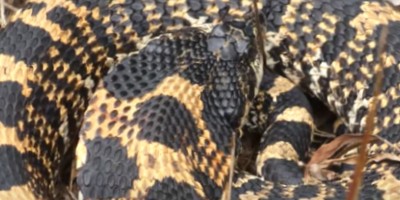 Eastern hog snake :
The eastern hog snake can easily be identified by the pointed edge of its upturned snout in front of the face. There is a color variation, from grey or black down to the back, with dark blotches, while some species have black with red patterns along the sides and stomach. Young ones are lighter in color and have a pinkish or orange tan. They have a length of 25-33 inches. The eastern hog snake can be found throughout the non-wetland regions of the state and along the margins of wetlands. They feed mostly on toads and frogs.
Eastern hog snake :
The eastern hog snake can easily be identified by the pointed edge of its upturned snout in front of the face. There is a color variation, from grey or black down to the back, with dark blotches, while some species have black with red patterns along the sides and stomach. Young ones are lighter in color and have a pinkish or orange tan. They have a length of 25-33 inches. The eastern hog snake can be found throughout the non-wetland regions of the state and along the margins of wetlands. They feed mostly on toads and frogs.
Venomous Snake Species in New Orleans
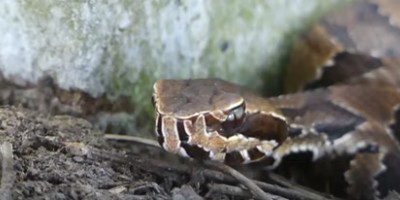 Cottonmouth snake:
This venomous snake can grow between 15-55 inches. The cottonmouth snake is dark tan, brown, or almost black, with dark black or dark brown crossbands. The snake has a black head with white lines running from the eyes to the corner of the mouth. Young ones have a pink or orange ground color, with dark brown crossbands on them, and a yellow tail. Some mature snakes possess the patterns of the young snakes. Cottonmouth snakes are found in swamplands, lakes, stream borders with dense canopies, and ponds. Cottonmouth snakes have a diet that consists of fish, mammals, turtles, frogs, tadpoles, lizards, birds, bird eggs, salamanders, and other snakes.
Cottonmouth snake:
This venomous snake can grow between 15-55 inches. The cottonmouth snake is dark tan, brown, or almost black, with dark black or dark brown crossbands. The snake has a black head with white lines running from the eyes to the corner of the mouth. Young ones have a pink or orange ground color, with dark brown crossbands on them, and a yellow tail. Some mature snakes possess the patterns of the young snakes. Cottonmouth snakes are found in swamplands, lakes, stream borders with dense canopies, and ponds. Cottonmouth snakes have a diet that consists of fish, mammals, turtles, frogs, tadpoles, lizards, birds, bird eggs, salamanders, and other snakes.
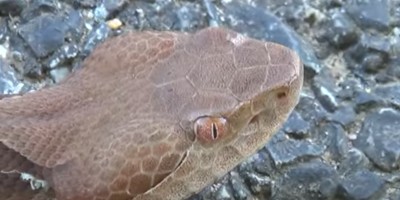 Copperhead snake:
The copperhead snake has a beige, tan, or dull gray color. Most times, there is a fair tinge of pale pink, or orange, with cross bands irregularly shaped like an hourglass, that is pale a bit on the lower sides of the snake. The head of the snake has no pattern but sometimes has a fair tinge of orange and pale yellow on the sides too. The young ones have a yellow tail, while the adults do not. Copperhead snakes have a length of 14-45 inches. They are found in edges of woodlands, ivy thickets, and south-facing slopes. They feed on small snakes, small birds, lizards, amphibians, and cicadas.
Copperhead snake:
The copperhead snake has a beige, tan, or dull gray color. Most times, there is a fair tinge of pale pink, or orange, with cross bands irregularly shaped like an hourglass, that is pale a bit on the lower sides of the snake. The head of the snake has no pattern but sometimes has a fair tinge of orange and pale yellow on the sides too. The young ones have a yellow tail, while the adults do not. Copperhead snakes have a length of 14-45 inches. They are found in edges of woodlands, ivy thickets, and south-facing slopes. They feed on small snakes, small birds, lizards, amphibians, and cicadas.
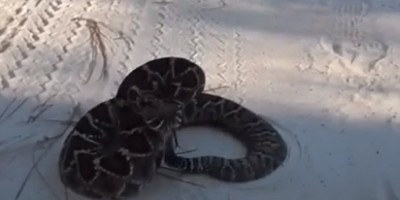 Eastern diamondback snake:
The eastern diamondback is the largest and most venomous snake. The snake has a brown to brownish-yellow ground color, with progressive dark, brown, or black diamond-shaped patterns down the back, rimmed with cream or yellow scales. They can grow up to a length of 8 feet. The eastern diamondback lives in pine flatwoods, coastal scrub, and sandy woodlands. They feed on small mammals like rabbits, squirrels, and birds.
Eastern diamondback snake:
The eastern diamondback is the largest and most venomous snake. The snake has a brown to brownish-yellow ground color, with progressive dark, brown, or black diamond-shaped patterns down the back, rimmed with cream or yellow scales. They can grow up to a length of 8 feet. The eastern diamondback lives in pine flatwoods, coastal scrub, and sandy woodlands. They feed on small mammals like rabbits, squirrels, and birds.
If you're unsure, you can email me a photo of the snake at info@neworleanssnakes.com and I will email you back with the snake's species. If you found a snake skin, read my Found a Skin? page, and you can email me a photo of the skin, and I'll identify the snake for you. If you need professional New Orleans snake removal help, click my Get Help page, or see the below website sponsor I found, who provides that service.
Remember, the term is not poisonous snakes of New Orleans, it's venomous snakes of New Orleans. Poison is generally something you eat, and venom is injected into you. That said, dangerous snakes are very rare in New Orleans. The few venomous snakes of Orleans County are rarely seen. But they are commonly misidentified, so learn about all the snake species of New Orleans in order to correctly identify them. These snakes are usually also found in the surrounding towns of Algiers, Aurora Gardens, Barrington Park, Camp leroy Johnson, Carrollton, Chef Menteur, Cutoff, East Gentilly, Faubourg Marigny, Ferncrest, Flamingo Recreational Vehicle and MH Park, Forest Isle, Garden District, Gentilly, Gentilly Terrace, Gentilly Woods, Greens Ditch, Greenville, Huntington Park, Idlewood, Kingswood, Lake Carmel, Lake Catherine, Lake Forest, Lake Oaks, Lake Terrace, Lakeshore East, Lakeshore West, Lakeview, Lakewood Country Club Estates, Little Woods, Lower Garden District, Michoud, Milneburg, Pike Fort, Pine Village, Place De Concorde, Pontchartrain Beach, Rigolets, Seabrook, Seabrook, South Point, Spanish Fort, Stanton, Storyville, Tall Timbers, Tamaron, Timber Grove, Venetian Isles, Vieux Carre, West End, West Lake, and the surrounding areas.
Read our article about:
Simple Home Remedies That Will Keep the Snakes Away
neworleanssnakes.com domain and hosting costs made possible by the generous support of this sponsor:
